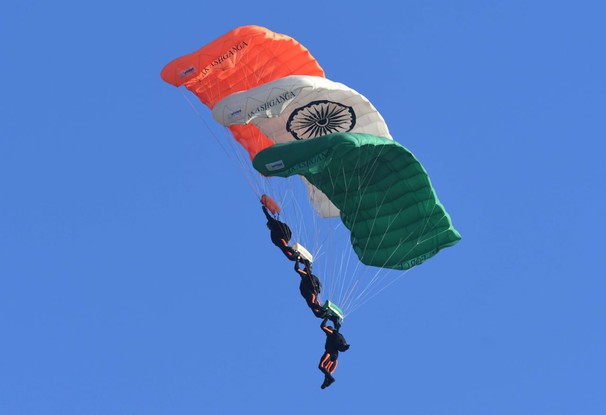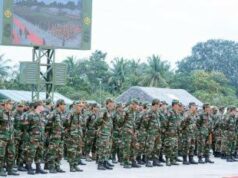IAF Still Retains It’s Edge Over PLAAF, Though 54 Squadrons Will Make It Comfortable

Jewel in the Crown: Rafale jets flying in formation over Hasimara Air Force base
According to Air Chief Marshal B S Dhanoa, Retd, When it comes to air power, India is hard to beat. Dhanoa, the architect of the Balakot strikes, says India’s adversaries would think twice before starting a war as the IAF holds a major edge in the region.
China is still in the process of integrating its land and air defence systems and its pilots. “The force-to-force balance between India’s China-facing air combat platforms and China’s India-facing ones still favours India,” he said. The Chinese Western Theatre Command has to face India’s Western, Central and Eastern Theatre Commands and and it cannot switch its Air assets from the Taiwan Front to the Tibetan Front.
The IAF still has an edge. However to be really comfortable and to cater for switching of Forces by PLAAF ex other Theatres, the IAF needs to be provided with 54 Squadrons. In fact to fight a two front war with China and Pakistan without much” JUGAD “ the requirement is of 63 combat squadrons. This kind of number will provide the IAF the ability to hit hard and hit deep inside both the fronts simultaneously.
When satellite images showed two Chinese J-20 stealth fighters parked in Hotan airfield in China’s restive Xinjiang region, IAF was not excited or perturbed. A senior Indian Air Force officer explained “Relax, China would never want an aerial skirmish with India, as it could expose its ‘hyped-up’ capabilities.” The new acquisitions and upgrades of existing capabilities have already given the IAF the visible ability to strike deep even in a contested airspace.
The IAF has acquired and strengthened itself in less than 12 months. Thanks to Dassault’s Rafale jets (two squadrons raised), Boeing’s Apache and Chinook helicopters and a modern fleet of transport aircraft, it has become a reliably versatile force. India has also integrated its formidable missile arsenal with the IAF fleet Sukhois, Mirage 2000 MiG29 and now the formidable TEJAS.
Now the 15-month-long LAC tensions between India and China have begin to ease, a lot of credit goes to the show of power through two armoured brigades and the IAF deployments. Both have prevented any further Chinese misadventure. Unlike 1962, when air power was not used, IAF fighters and attack helicopters had made their presence known during the Ladakh standoff. The new acquisitions and upgrades of existing capabilities have given the IAF the visible ability to strike deep in contested airspace over Chinese Occupied Tibet. “It’s good that we are getting the best available aircraft in the world,” said a former air chief. “It gives technological advantage over our immediate neighbours. But, I believe we need more numbers.”
So the focus is now on gaps and deficiencies. With more than 1,700 aircraft—around 900 of them fighters—the IAF is the world’s fourth largest air force. It has a mixed inventory sourced from the US, Russia and Europe. The IAF is now streamlining and upgrading its fleet of Jaguar, Mirage-2000, MiG-29 and Sukhoi Su-30MKI fighters. Half of the 116 Jaguars are being given DARIN III (Display Attack Ranging Inertial Navigation) upgrades, which involves providing a new radar, a fully integrated electronic warfare suite, smart multi-function displays, new avionics and a new attack system. There is also a plan to have a more powerful engine (Honeywell F-125IN) for 80 Jaguars. IAF officials say they are not in hurry—the fleet still has 15 more years of life. Also, apart from upgrades planned for 59 existing MiG-29s, the IAF is also acquiring 21 more MiG-29s and has issued a tender for 114 fighter jets to be manufactured in India on a transfer-of-technology basis.
Experts say the IAF can match, or even better, the Chinese air force in a limited air war. The missile arsenal also gives the IAF a strong advantage. Integrated with fighter jets are a variety of missiles—from the deadly BrahMos and the Advanced Short Range Air-to-Air Missile (ASRAAM) to the long-range, air-to-air Python 5 and MICA missiles. The Air Force also has SPICE-2000 air-to-ground missiles (of Balakot fame) and HAMMER (Highly Agile and Manoeuvrable Munition Extended Range) air-to-ground precision-guided weapon systems. “Most fighter jets have been integrated with these missiles systems,” said a top IAF officer. “It enhances not just the firepower multiple times, but also the morale of our pilots.”
China has more than 2,000 combat aircraft, including J-20, J-10, J-11 and Su-27 fighter jets. It also has a long-range strategic bomber fleet, around 20 AWACS (airborne warning and control system) aircraft, and a variety of combat drones. The Chinese air force may have a numerical advantage, but military observers say it suffers from a lack of combat experience. Moreover, most Chinese fighters are a result of reverse-engineering, making it less reliable than a western aircraft.
So apart from the incoming squadron of MiG 29, the induction of four squadrons of TEJAS MK1A and at least 6 Squadrons of TEJAS Mk2 have to be speeded up. Also at least two more squadrons of Rafale would really add the missing strike power.
According to Dhanoa, the combat experience of the People’s Liberation Army Air Force remains sketchy. Since its bombing mission in the Korean war, the PLAAF has not carried out any offensive missions. “The IAF is now fully capable of sorting out both Pakistan and China,” said Air Marshal SBP Sinha (Retd), former deputy air chief who played a key role in bringing Rafale into India. “With its current strength of fighter aircraft, the IAF will get stretched to an extent in a collusive two-front scenario, but it will still manage because of its excellent training and operational preparedness.”
The induction of Rafale jets and the formation of the second squadron of the TEJAS have boosted numbers. “The Rafale brings in game-changing capabilities,” said Air Marshal Anil Chopra (Retd) of the Centre for Air Power Studies. “Rafale is better than anything that the PLAAF has to offer.”
Private industry is also helping enhance the IAF’s combat abilities. Larsen & Toubro has been part of various prestige military projects. “For the TEJAS program, L&T supplies complete wings,” said JD Patil, board member and whole-time director (defence and smart technologies), L&T. “We are also a production partner in a range of airframes, fuselage composite structures, control surfaces and stabilisers and flight control linkages for Advanced Light-utility Helicopter (ALH) and Light Combat Helicopter (LCH). L&T’s contribution to the Mirage upgrade is through supply of under-wing launchers and MICA missile sub-systems through offset from MBDA.”
The first regimental set of the S-400 air defence system will be delivered this year. It has short-, medium- and long-range missiles, with ranges going up to 400km. “It has a phenomenal capability that will pose a serious threat to China’s H-6K bombers and their AWACS and flight refuelling aircraft. It will deter fighter strikes,” said Chopra.
The location of the airfields, perhaps, gives the IAF its biggest advantage over China. Indian airbases are within 100km of each other, while Chinese bases in Tibet are as far apart as 400km. Fighter operations need deployments in airfields that offer mutual support.



